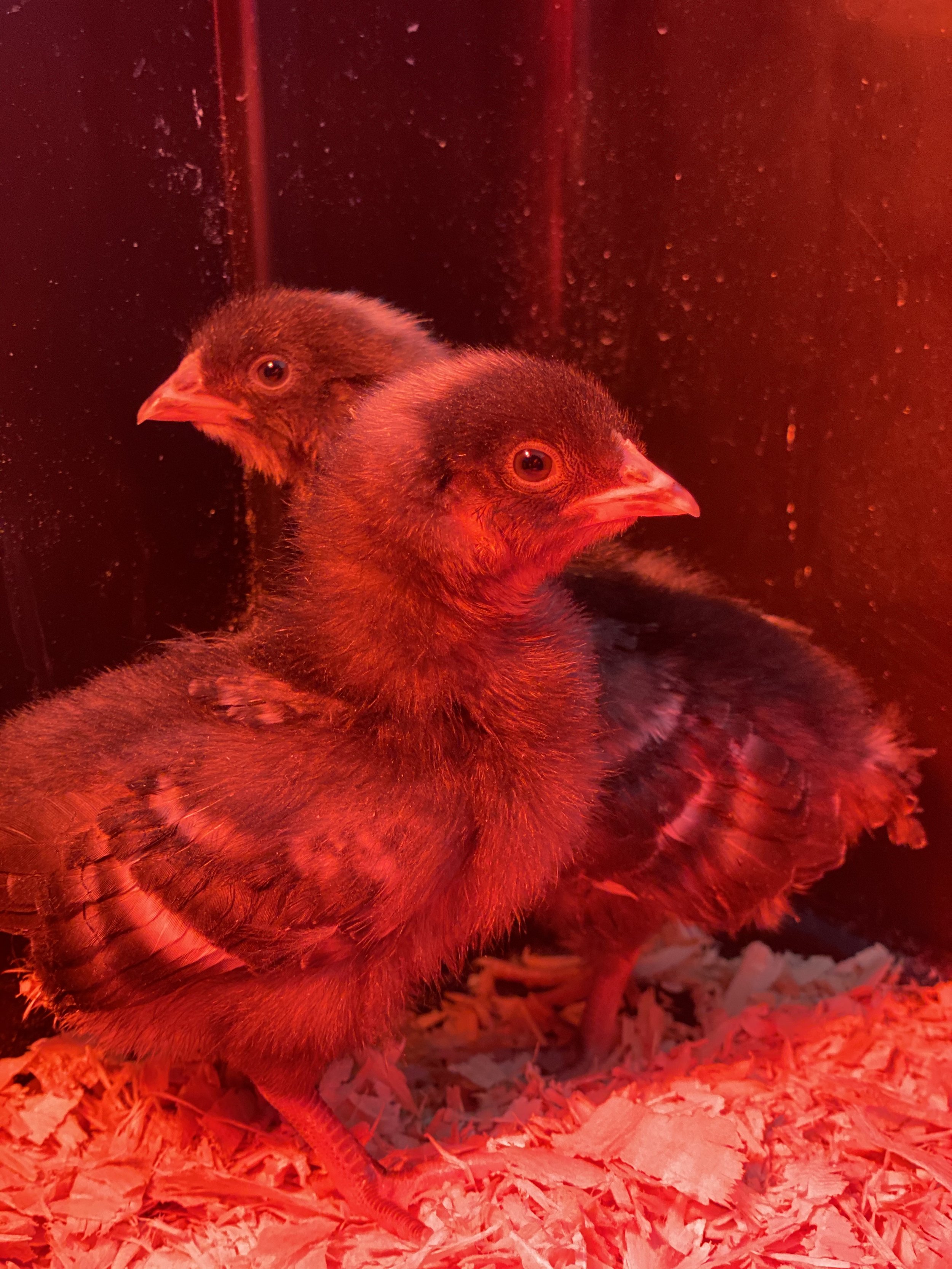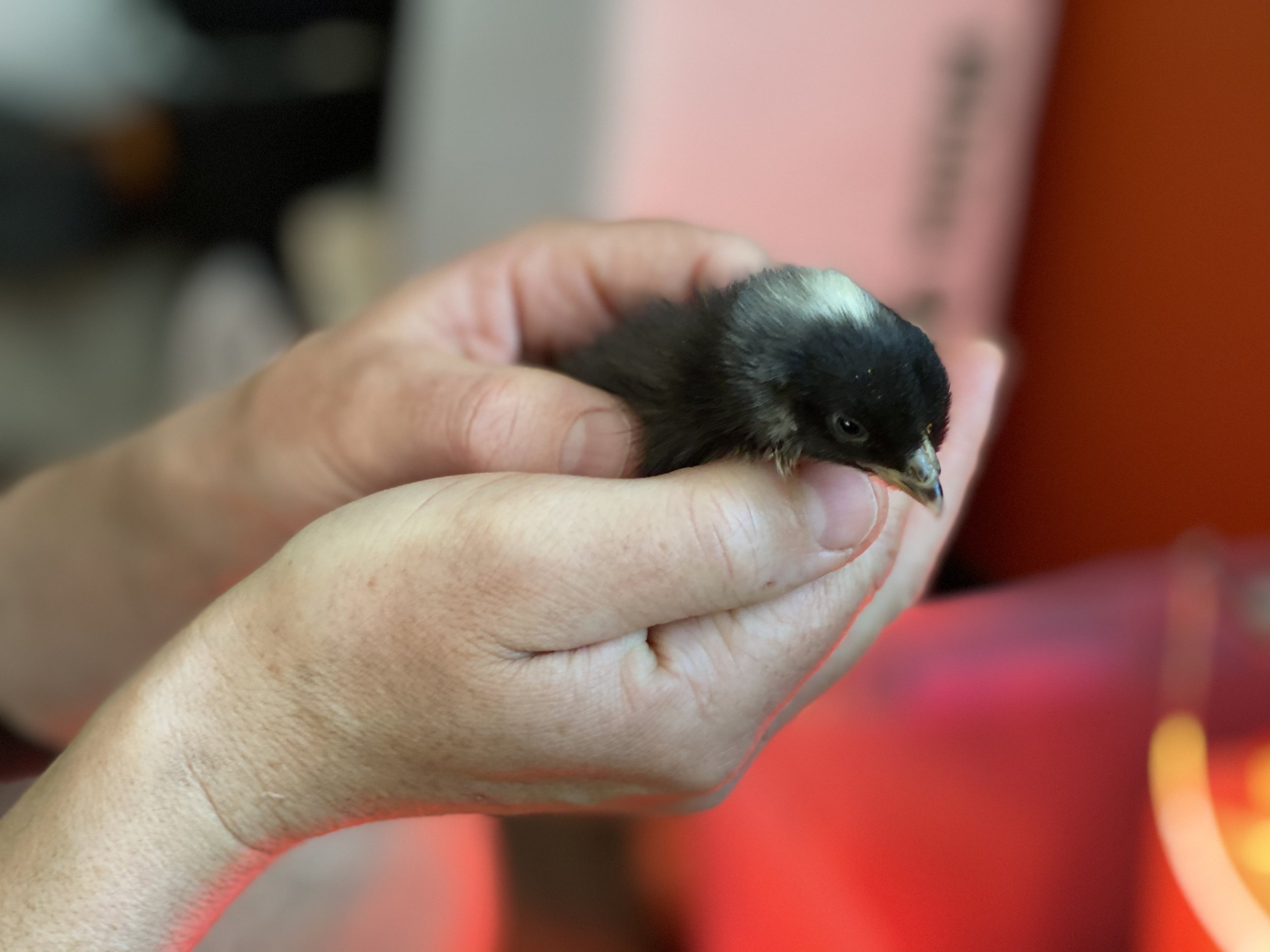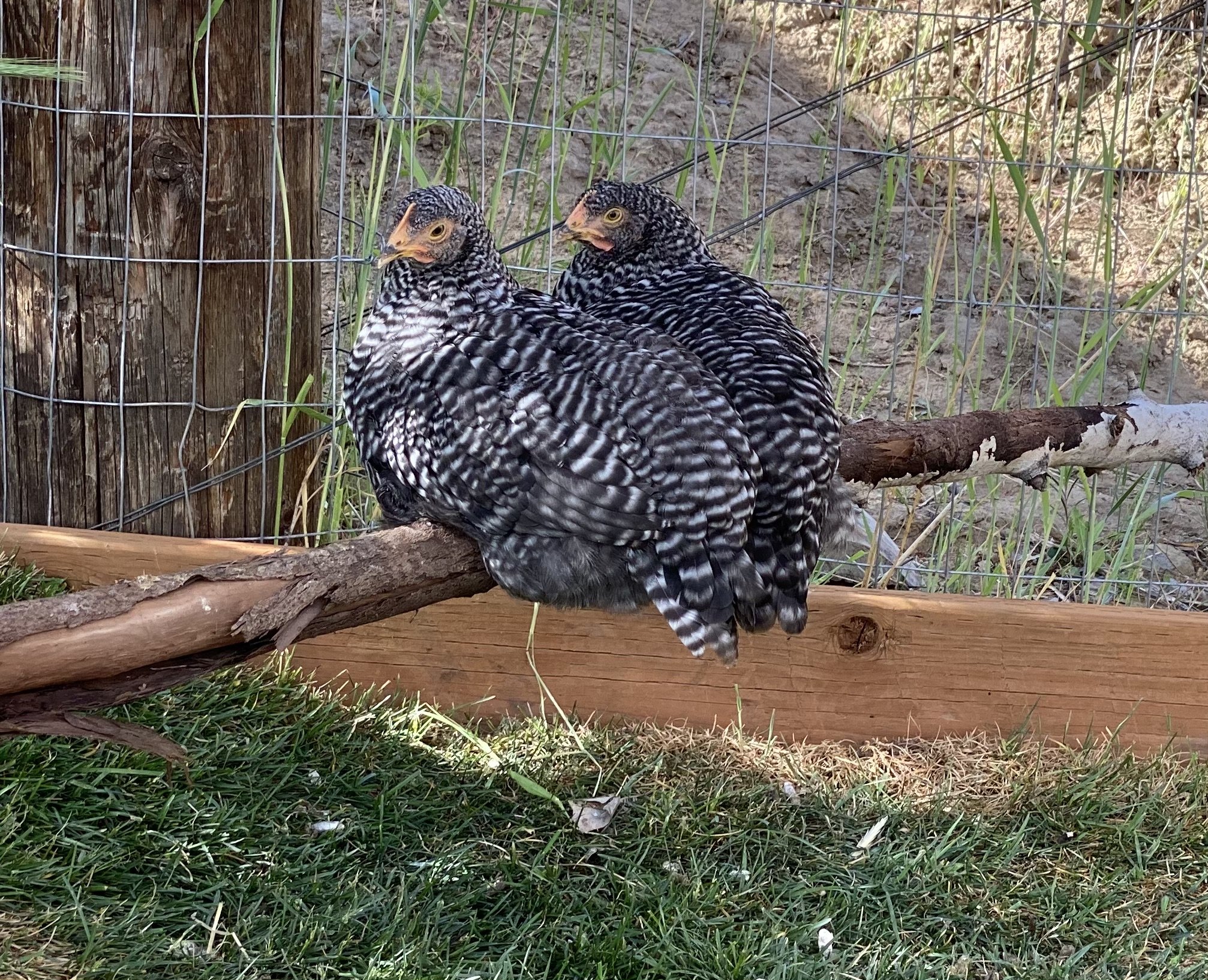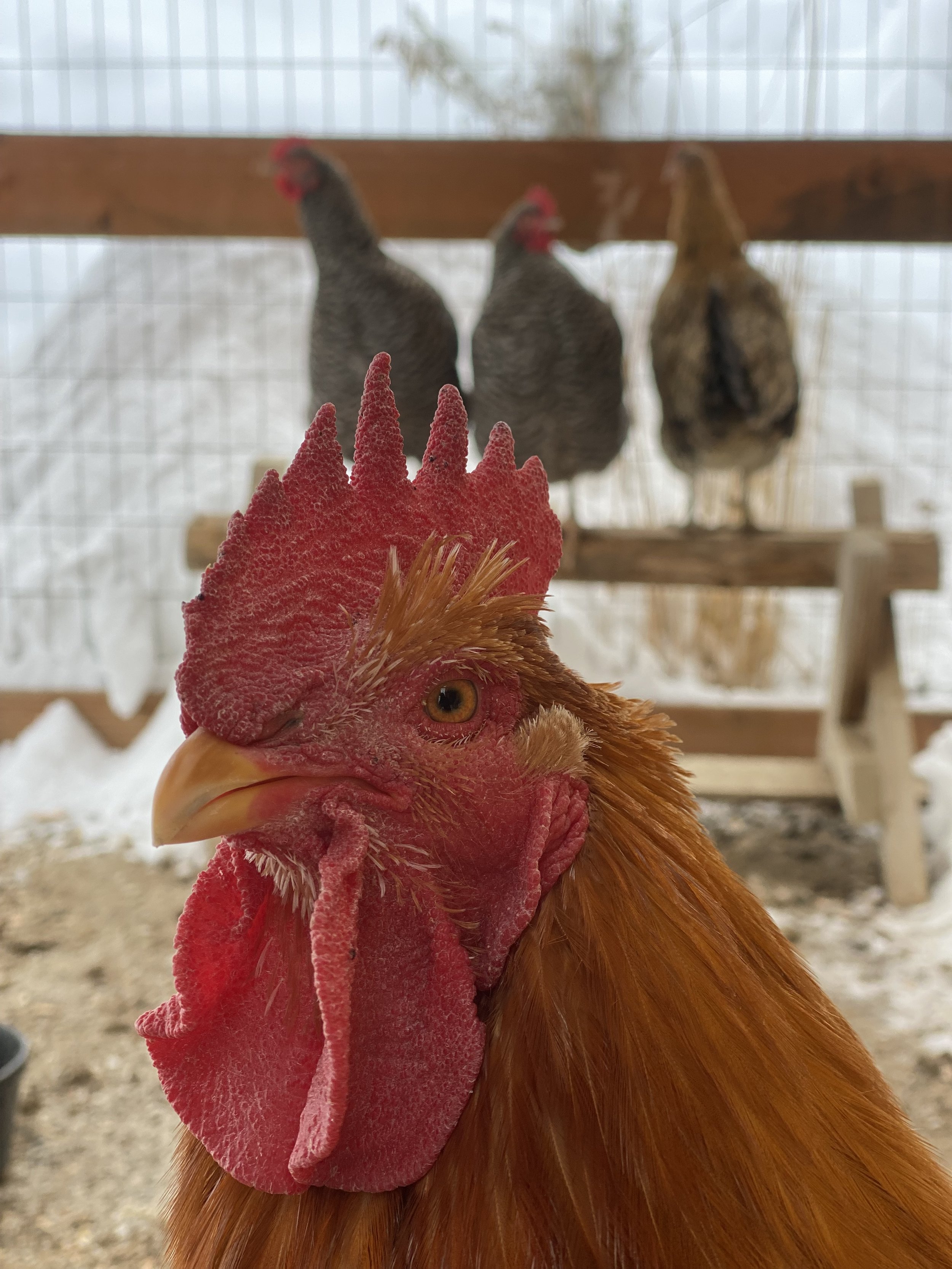What about Eggs?
In honor of Astrid.
Astrid saying “Hi!”
As is the case for most hens, Astrid did not start out life under her mom’s wings as nature intended. Instead, she was hatched under artificial heat, among thousands of other chicks. Shortly after being hatched; scared, fragile, and cold she was put in a barren cardboard box and shipped through the mail. Sadly, this is reality for the millions of hens hatched each year to be used for egg production.
Astrid & Kaisey’s first day home
Growing quickly
Astrid had been ordered (a common practice for how people get chicks, ducklings, goslings and poults), but they decided not to show at the post office that day. Needing to be at a temperature +95 degrees in the first week of life, she struggled for survival overnight in the empty cardboard box among her hatch mates. Our local feed store went to pick up their “order” of baby birds and agreed to also take the ones that had been left. Ironically, that is the day Eric and I decided to stop in for supplies. Spring is a difficult time for us to shop at the feed store, hearing the multitude of innocent chirps of baby birds searching for their mothers. It was not any easier that day, as I looked over the edge into the big tubs they were kept in, only to see many laying perished on the bottom, with feathered friends walking all over them. I watched a young employee try to keep up with retrieving the dead birds and putting them out of view before the surrounding customers could notice. We asked if we could rescue a few. They agreed, and we were able to choose four who were struggling to survive, but seemed to have a fighting chance. (Full story here.)
Gentle embrace for cleaning
Getting feathers
The four of them were plucked from their mates and once again placed into an empty cardboard box, for yet another trip to the unknown on day two of life. However, they were four of the lucky ones, brought home to a safe, cozy warm space set up just for them. Care around the clock and a life to look forward to of love, respect, and freedom.
Old enough to live outside
Despite our best efforts we lost two within a few hours. Kaisey was strong considering all she had been through in her first few days, but Astrid was touch and go. They had poopy little butts and required around the clock care, cleaning their vents (poop/egg hole) ever two hours to make sure it didn’t get blocked, which could be lethal. This was mandatory until their little systems could recover and heal.
Roo protecting his ladies
What about the males? After being hatched, chicks are sorted between male and female. This is not 100% accurate, but since males cannot lay eggs and they don’t get as large as chickens used for meat, the industry has deemed them useless. Within 24 hours of hatching, they are killed. Often this is done by grinding them alive, gassing or suffocating them in plastic bags. Up to 7 billion male chicks are killed each year in the egg industry.
Why not sell them as well? Often folks don’t want roosters because they don’t lay eggs. Also, many places have noise ordinances that don’t allow roosters.
Afternoon’s rest
Bath time
Astrid was a fighter. She hung on and grew up to be a healthy hen! Her and Kaisey were inseparable. Always together, it was often difficult to tell them apart. The one true way was by their eyes. Sometimes they had to be right next to each other to be sure. Astrid was also the more friendly, outgoing one. She would jump on my shoulders while cleaning their house. Always coming over to say “HI”, and see if I had anything she was interested in. Astrid seemed to have a happy spirit, and I saw her as adventurous, curious, active, a leader, gentle, and kind. She was a loving companion to her bird friends.
Always together
Best Friends
Egg-laying hens in the industry are typically kept in cages. Their beaks commonly trimmed without anesthesia or pain killers, which is painful to them. Hens are considered “spent” after 1-2 years old and are slaughtered for pet or livestock food.
“Backyard chickens” are popular and though some may live a more natural life, their start is often the same. If chicks aren’t hatched naturally by their mother hen or rescued, they are served the same fate as Kaisey and Astrid. They are artificially hatched, shipped through the male in the first days of life, the males are culled, and often the hens are still killed at 2-3 years old, when their egg production slows.
What about Free Range Eggs?
Even “Free Range” chicken producers remove parts of the hens’ beak in the first few days of life. Some starve their birds to force molting (loss of feathers) to manipulate the laying cycle. And virtually all commercial operations are supplied by hatcheries that kill male chicks shortly after hatching.
Ladies foraging for bugs and seeds
The natural lifespan of a chicken is 7-8 years old. Mothers will talk to their chicks through the egg before they are hatched, so once out of the shell a chick can recognize their mom by her sounds. Hens naturally would only lay about 12-15 eggs per year, but they have been bred to lay around 300 eggs per year, to keep up with human demand. Laying so many eggs has many health concerns for hens.
A reproductive issue took Astrid’s life. Suddenly, one morning she did not get off her roost. Roo watched over her in the yard where she walked around a bit, but obviously something was wrong. I brought her in the house, gave her a long warm bath, playing soothing music and sitting by her side. She lost interest in drinking and eating, so we hopped in the car and headed to Washington State University Veterinary Hospital. After an exam, x-rays, and discussion, we determined surgery was the only way to possibly save her. She made it through surgery, but sadly just a few hours after her body decided it was all too much and she passed over the rainbow bridge. Multiple yolks had stacked up inside of her. It was not a typical calcium issue, as many hens have. The vets were uncertain the cause and had not seen the same circumstance before, but assured us there was nothing different we could have done.
Last moments before surgery
Chickens are intelligent and very social animals. They can distinguish more than 100 faces of their own species and humans. They can self-recognize. They can understand basic counting. Chickens have shown to be able to anticipate the future and demonstrate self-control – something previously attributed only to humans and primates.
Astrid and Erin just chillin’
So what would you use instead of eggs?
Just to eat: Just Egg, Tofu, Chickpeas
To cook with: Ground Flaxseed, Applesauce, pumpkin, or a premade egg-replacer
She loved scratching through fresh straw each day after cleaning the barn
It is clear Kaisey, Elen, Roo, and Jose miss their companion. We brought her body home and gave them a chance to say goodbye. They ran toward me when I held her in my arms. Pecking at her face to try to wake her up and get some sort of reaction. They circled, then stood over her body seeming to mourn their loss.
Spring bird yard
As tender and precious most of us feel life is, we create it and steal it unconsciously from billions of other beings with each passing second. All without necessity. In honor of Astrid and all farmed animals this day, we invite you to make a difference and enjoy a plant-based meal; free of cruelty.
Niece Bennett enjoying time with the young ladies.
We love you, Astrid and miss you each day.
Sources; https://unitedegg.com/facts-stats/; https://www.npr.org/sections/thesalt/2016/10/28/499613622/technology-may-rescue-male-baby-chicks-from-the-grinder; https://www.sciencedirect.com/science/article/pii/S0032579119310636?via%3Dihub;https://www.smithsonianmag.com/innovation/can-new-technologies-eliminate-grim-practice-of-chick-culling-180977263/; https://ohio4h.org/sites/ohio4h/files/imce/animal_science/Poultry/Chicken%20Breed%20Selection%20_%20Ohioline.pdf; https://extension.psu.edu/programs/4-h/opportunities/projects/animal-science/poultry/raising-rearing/viii-other-online-resources/the-chicken/modern-egg-industry; https://pubmed.ncbi.nlm.nih.gov/14979568/; https://www.thepoultrysite.com/articles/finding-the-value-in-processing-spent-laying-hens; https://www.merckvetmanual.com/behavior/normal-social-behavior-and-behavioral-problems-of-domestic-animals/social-behavior-of-chickens; https://modernfarmer.com/2016/03/chicken-facts/; https://www.psychologytoday.com/us/blog/smarter-you-think/202101/counting-chickens-right-after-they-hatch; https://poultry.extension.org/articles/poultry-anatomy/how-well-can-chickens-see/; Discovery Magazine; https://www.farmsanctuary.org/chickens/; https://unitedegg.com/facts-stats/; https://www.thepoultrysite.com/articles/finding-the-value-in-processing-spent-laying-hens; https://www.sciencedirect.com/science/article/abs/pii/B9780081009154000099; https://livestock.extension.wisc.edu/articles/life-cycle-of-a-laying-hen/


















